DESIGN PAPER 1 GRADE 12 MEMORANDUM - AMENDED SENIOR CERTIFICATE EXAMS PAST PAPERS AND MEMOS MAY/JUNE 2018
Share via Whatsapp Join our WhatsApp Group Join our Telegram GroupDESIGN
PAPER 1
GRADE 12
AMENDED SCE PAST PAPERS AND MEMOS
MAY/JUNE 2018
MEMORANDUM
SECTION A: DESIGN LITERACY
QUESTION 1: 'UNSEEN' EXAMPLES [10 marks]
Answer EITHER QUESTION 1.1 OR QUESTION 1.2.
1.1 (Allocate a maximum of 2 marks for each bullet/aspect) 
The use of material in this pendant is an unusual combination of copper and brass materials that have been forged into contrasting forms. ? The material has been exposed to heat to make it malleable in order to stretch and shape the metal by beating it on a metal block or a mandrel. ? The copper has been treated to create a patina that makes it appear leather-like to suggest the idea of a corset. ? The turquoise stone adds variety and contrast in creating a striking design. ?
The bronze, copper and turquoise pendant is possibly inspired by the human form. ? The bronze wire lacing effect in the copper is reminiscent of a woman's corset and the blue, oval, turquoise stone implies a human head. ? The stone is attached to the pendant with a brass piece that looks like the neck and spine of a woman. The two curved brass pieces that attach to a chain that fastens around the neck could be inspired by clavicle bones. ?
The forging of the metal allows the designer/jeweller to create contrasting forms. The organic, copper form that resembles a corset contrasts with the mechanical simplified forms in brass resembling the body of a woman. ? The repetition of the oval form of the stone in the oval loops that attach to the chain creates a sense of rhythm. ? The form of the pendant as a whole is functional and will hang comfortably around the neck of the wearer.
The focal point is the turquoise stone. Its contrasting oval shape attracts the eye immediately. ? Additionally, it is the only cool colour in the warm yellow and red colour scheme created by the metals. ? The horizontally curved line leads the eye to the stone. The vertical line of brass that holds the turquoise stone leads the eye up to the stone. ?.
The cool blue colour of stone contrasts with the warm, yellow brass and red copper metals. ? The copper has been treated to produce a warm red patina. ? The warm, yellow brass and red copper metals create a sense of unity. ? [10]
Q.1.1 LEVEL | COGNITIVE SKILLS | WEIGHTING | QUESTIONS | MARKS (10) |
Lower Order | Remember, Recall, Recognise | 30% | 1.1 | 2 |
Understand, Explain, Describe | 1.1 | 1 | ||
Middle Order | Apply, Implement, Organise | 40% | 1.1 | 4 |
Higher Order | Analyse, Interpret | 30% | 1.1 | 1 |
Reflect, Judge | 1.1 | 1 | ||
Synthesis | 1.1 | 1 |
OR
1.2 [Allocate a maximum of 2 marks per design term for a total of 10 marks] 
The composition is made up of many organic lines that could be inspired by the Art Nouveau movement's whiplash line. ? The curvilinear lines that create frames around the mealies derived from the shape of the fibres at the top of each mealie and the shape of the mealie-meal bag. ? The diamond shape created by the lines produces a very dynamic half drop pattern. ?
Variation in tone is created in the design by the rendering technique used on the subject matter. A shading technique of fine lines is used to create 3-dimensionality and variation in tone as the highlighted motifs appear to be realistic on a flat dark background. ? The shading technique contrasts with the flat green background and simplified silhouettes of flying eagles and wings. ?
This contrast also creates a dynamic pattern surface. ?
? The subject matter of the wallpaper could possibly be inspired by the Arts and Crafts movement that used the everyday fauna and flora ? British designers found themselves surrounded by subject matter – like strawberries and small birds that lived in hedges. Similarly, the South African designer, Quagga, uses as subject matter the fauna and flora of South Africa, i.e. a mealie cob grown mostly in the Free State and acorns found in the Cape. ? The small brown birds of the Arts and Crafts movement that live in shrubs are substituted by the South African bird of prey, an eagle. ? Bags of mealie-meal, a staple diet for many South Africans, show the true South African influence. ?
The lines around the mirror image of the mealies and single large acorns create a symmetrical balance. ?The same balance occurs within the mirror image of the bags of mealie-meal that are framed with a curving whiplash line. ? The wallpaper has a drop repeat overall pattern made up of smaller symmetrically balanced units. ? This symmetrical balance stabilises the movement created by all the organic lines. ?
Rhythm is created by the repetition of the pattern units. ? The shape of the mealie kernels is repeated with the small dots that diminish in size, enclosed between the double outline at the top of the mealies, also creating a rhythm. ? The alternating direction and size of oak tree leaves that are arranged diagonally create a rhythmic vertically arranged pattern. ? [10]
Q.1.2 LEVEL | COGNITIVE SKILLS | WEIGHTING | QUESTIONS | MARKS (10) |
Lower Order | Remember, Recall, Recognise | 30% | 1.2 | 1 |
Understand, Explain, Describe, Classify | 1.2 | 2 | ||
Middle Order | Apply, Implement, Organise | 40% | 1.2 | 4 |
Higher Order | Analyse, Interpret | 30% | 1.2 | 1 |
Reflect, Judge | 1.2 | 1 | ||
Synthesis, Justify | 1.2 | 1 |
QUESTION 2: COMMUNICATION THROUGH DESIGN [10 marks] 
2.1 (Allocate 6 marks)
The fist ? placed above Mandela's head is a symbol of power and resistance. ? The white doves ? in the two top corners above the bullets are symbols of love and peace. ? The ballot box ? with paper with a cross on, in the rectangle in the middle of the top quarter of the poster, is a symbol of democracy. ? The horns ? jutting out on either side above the images of Mandela and Charlize could be symbols of Africa with the kudu being so abundant in Africa. ? The red hearts ? placed next to the bullets are symbols of love. ? The cranes ? in each
corner at the bottom of the poster could symbolise development and industry. ? Black and white hands ? holding each other symbolise unity and harmony between the two races. ?
Credit must be given to any other valid symbols and their meanings. (6)
2.2 (Allocate 4 marks)
The poster reflects 'cultural diversity' as it makes use of images and symbols that refer to various races, cultures and subcultures that form part of the broader community of South Africa. ? The round discs with triangular patterns refer to the earrings of the Zulu culture and the image of Charlize Theron could refer to the Western culture. ? Kwaito is a form of music that belongs to a specific subculture in South Africa. ? Various images refer to the different races that form part of our society, for example, the black and white hands holding each other and the white faces emerging from a sky with clouds above the head of Mandela. ? The poster puts all these images together to form a balanced and unified whole. The message communicated is that unity can be achieved even though South Africa is culturally so diverse. ? The fact that these images are placed to form a symmetrical whole conveys a sense of order and balance. ? The use of bright colours, like yellow, red, green and blue communicate happiness and vibrancy. ? Credit must be given to any other valid statements. (4) [10]
Q.2 LEVEL | COGNITIVE SKILLS | WEIGHTING | QUESTIONS | MARKS (10) |
Lower Order | Remember, Recall, Recognise, Name | 30% | 2.1 | 3 |
Understand, Explain, Describe, Classify | ||||
Middle Order | Apply, Implement, Organise | 40% | 2.1 2.2 | 3 1 |
Higher Order | Analyse, Compare, Interpret | 30% | 2.2 | 3 |
Evaluate, Reflect, Judge |
QUESTION 3 [10 marks]
Answer EITHER QUESTION 3.1 OR QUESTION 3.2.
3.1 [10 marks] (Allocate a maximum of 2 marks for each bullet/aspect) 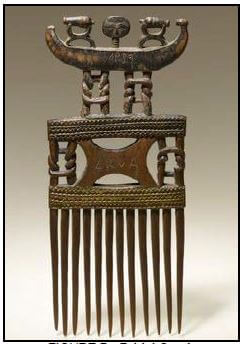
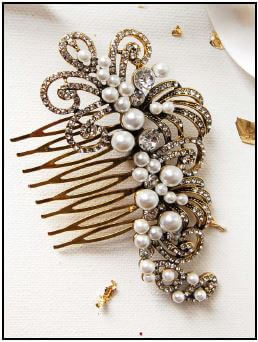
FIGURE D is possibly influenced by the geometric lines, forms and patterns of other traditional African wooden carved products and sculptures (credit can also be given if learners refer to the use of geometric lines by the Art Nouveau designer, Mackintosh), ? whereas FIGURE E's lines and shapes are reminiscent of the curvilinear lines used in Victorian and Art Nouveau combs.?
Both combs are used to decorate the hair. ? FIGURE D also functions as a ceremonial gift to acknowledge an imminent wedding ? whilst FIGURE E is worn as decoration during a wedding and other occasions, like a matric dance function. ? The shiny quality of FIGURE E signifies that it is probably used for smart evening functions. ?
The texture in FIGURE D is a combination of smooth and tactile surface detail. ? The horizontal bands show inscribed/engraved texture that contrasts with the smooth surface texture of the vertical 'bristles' of the comb that create a dramatic contrast. ? The variety of materials used in FIGURE E show tactile texture conveying lively movement and femininity. ? The smoothness of the pearls contrasts with the diamond encrusted, rough texture of the decorative curvilinear motifs. ?
FIGURE D combines rigid, horizontal, stylised, incised diamond decorative patterns with vertical, twirling, knotted strips, ? whereas FIGURE E uses of glittering, diamond-like stones and shiny pearls to form organic, leaf-like spiralling decorative patterns. ? FIGURE D is simplified and geometric in comparison to the complex, 'over the top' glitter appeal of FIGURE E. ?
FIGURE D is carved out of wood which gives it an organic, handcrafted character ? whereas FIGURE E consists of synthetic materials, like plastic, synthetic pearls and imitation diamonds typical of costume jewellery. ? FIGURE D has a durable quality whereas FIGURE E seems more fragile and breakable. ?
Credit must be given to any other valid statements.
NOTE: A maximum of ONLY 3 marks may be allocated for tabular comparison responses. Use the cognitive levels as guidelines. [10]
Q.3.1 LEVEL | COGNITIVE SKILLS | WEIGHTING | QUESTIONS | MARKS (10) |
Lower Order | Remember, Recall, Recognise | 30% | 3.1 | 1 |
Understand, Explain, Describe | 3.1 | 2 | ||
Middle Order | Apply, Implement, Organise | 40% | 3.1 | 4 |
Higher Order | Analyse, Compare, Interpret | 30% | 3.1 | 2 |
Evaluate, Reflect | ||||
Create, Synthesise | 3.1 | 1 |
OR
3.2 [10 marks] (Allocate a maximum of 2 marks for each bullet/aspect.) 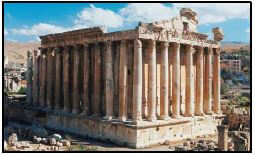
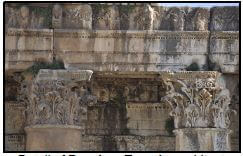
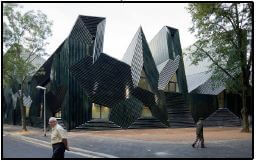
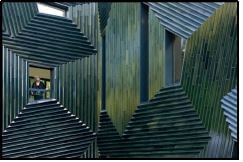
The function of the contemporary Synagogue in Mainz, seen in FIGURE G, is not at first evident as it is an unconventional, unique and modern structure which does not refer to traditional temple forms in any way. ? The temple of Bacchus in FIGURE F, on the other hand, is a familiar temple form and it is clearly a religious space in which to worship. ? FIGURE G combines public functions with religious functions. The orientation of the building in FIGURE G towards the East allows for two squares or open spaces to be created: an internal community garden functions as a place for recreation and celebration and a public square in front of the main entrance, facing towards the city centre, creates an open space for the neighbourhood within a densely built-up urban area. ? This synagogue complex in FIGURE G also functions as a place for adult education and a Hebrew school for children. The absence of any kind of gating or barriers means that it functions as a truly public space that is used for everyday activities, rare for a religious building, especially for a synagogue, in Germany. ?
The monumental, rectangular, simple structure of FIGURE F is situated on an immense raised plaza. ? The entablature rests on forty-two 19 m high, upright, unfluted Corinthian columns, banded together with iron, creating a typically classical structure dominated by horizontals and verticals. ? The structure of FIGURE G is, on the other hand, far more complex consisting of a very jagged and angular façade. ? The form is abstractly based on the Hebrew word for blessing and is curved around the public courtyard. ? The structure uses a perspectival play of three-dimensionality using multiple perspectives with the windows representing their vanishing points. ?
A variety of natural materials were used in the structure of FIGURE F. The columns, bases and capitals are made of limestone while the shafts are made of polished red Egyptian granite that supports the richly carved entablature. ? On the inside, the cella is decorated with Corinthian 'half-columns' flanking two levels of niches on each side, containing mosaic scenes of the birth and life of Bacchus. It is thought that the columns were erected in a rough state and only rounded off and polished once in place. ? The spatial quality of FIGURE G is enhanced by the use of repeated strips of transparent green ceramic tiles, which reflects the changing light conditions of its surroundings and creates a wide array of hues and shades. ?
The basilica style temple of Bacchus in FIGURE F, situated within the temple complex of Baalbek is one of the best preserved and grandest Roman temple ruins in the world. Influenced by the Ancient Greek and Mycenae architecture it is thought to have been constructed between 50 and 250 CE. ? The alternating high and low pointed shape of the Mainz Synagogue in FIGURE G is inspired by Hebrew writing and its relationship to space. ? In order to integrate this Jewish community centre (synagogue) into the residential neighbourhood of the Mainzer Neustadt that dates back to the late 19th century, the architect is also influenced by the use of a 'perimeter block pattern or enclosed courtyard' (Perimeter Building/Blockrandbebauung) which is a dominant architectural style in this urban area. ? Its jagged, fragmented structure also reflects the influence of the Deconstructivists' use of unstable, geometric fragmentation. ?
The temple of Bacchus is known for its impressive dimensions, richly decorated stone work and monumental gate with Bacchic styled figures. ? Enriched by some of the most refined reliefs and sculpture to survive from antiquity, the decorative stone carving on the architrave and frieze include rows of lions and bulls, which were motifs symbolically associated with the two deities. Its ornamentation served as an influential model for Neoclassical architecture in the 18th century. ? The technology needed to create the architrave structure is evidence of the Roman engineering capabilities. Blocks weighing from 66 tons to 100 tons were raised 19m above ground level using cranes and earthen banks to roll the blocks of limestone into position. ? The decoration of the synagogue in FIGURE G is far more uniform and simple than that of the temple in FIGURE F. ? The surface is covered completely in strips of glazed ceramic tiles. This surface as well as the various angles of the walls creates a visually exciting decorative, rippled and three-dimensional effect. ?
Credit must be given to any other valid statements or a comparison of a Classical and contemporary building that the candidate has studied.
NOTE: A maximum of ONLY 3 marks may be allocated to tabular comparison responses. Use the cognitive levels as guidelines.
Q.3.2 LEVEL | COGNITIVE SKILLS | WEIGHTING | QUESTIONS | MARKS (10) |
Lower Order | Remember, Recall, Recognise | 30% | 3.2 | 1 |
Understand, Explain, Describe, Classify | 3.2 | 2 | ||
Middle Order | Apply, Implement, Organise | 40% | 3.2 | 4 |
Higher Order | Analyse, Compare, Interpret | 30% | 3.2 | 1 |
Evaluate, Reflect | 3.2 | 1 | ||
Create, Synthesise, Justify | 3.2 | 1 |
TOTAL SECTION A: 30
SECTION B: DESIGN HISTORY
QUESTION 4 [30 marks]
4.1 Allocate 20 marks in total.
Allocate 10 marks for each movement. Note that ONLY ONE mark can be allocated for the name of a designer and product of each movement. Use the cognitive levels as guidelines.
This marking guideline supplies an answer for the following two possibilities:
- Neo-Classicism
- Deconstructivism
Neo-Classical designs aim to create simplified and ordered buildings or products that are balanced, calm and stable. ? They are influenced by the Classical ideals of the Greek and Roman eras. ? The designs reflect a revival of Classical building elements such as the column, colonnade, arch, pediment, entablature and portico. ? The aim is to use these elements to create harmonious, ordered structures that exude a sense of control, clarity and dignity. ? Neo-Classical design is a deliberate reaction to the excesses of Rococo design. The focus is now on ideals of virtue, honour, moral principles and responsibility. ?
Characteristic of this movement is the depiction of medallions, vine leaves, scrolls, Classic vases, natural elements and characters from ancient mythology, such as sphinxes and griffins. ? Typical of Neo-Classical buildings is the fact that they are mostly white which adds to the sense of purity and stillness. ? Columns are tall – almost to the full height of the building and repetition of these columns and colonnades is extreme, adding a sense of grandeur. ? Compositions are symmetrically balanced with an emphasis on proportion. ?
The USA Congress building by Thornton, Latrobe and Bulfinch, ? America, 1793–1830, expresses this simplicity and clarity very well. ? It has a completely white exterior, typical of Neo-Classicism, exuding calmness and purity. ? The design has an impressive dome and possesses an oculus similar to the Pantheon. Typical of Neo-Classicism is the repetition of tall columns and colonnades conveying order and stability. ?
Deconstructivist designs aim to subvert traditional ways of seeing and depicting. ? They aim to pull things apart and to investigate the relationships between the different components of a building or product. ? Their works are distorted, fragmented and re-assembled to illuminate new relationships which appear unstable and disrupted. ? The viewer is invited to find meaning in chaos, imbalance and disintegration. ? These designs exaggerate and dramatise. ?
Deconstructivism influence grew out of the writings of the French philosopher, Jacques Derrida, and his theory of deconstruction which states that deconstruction is evident at all levels of life and is the result of the interaction of opposites which exists in an unstable environment.? Other influences on Deconstructivist designs are the faceting of Cubism as well as the faceting, geometrising and emphasis on dynamism of Futurism.? The exploring of meaning to be found in non-aesthetic materials of Dada is another influence. ? Deconstructivism rejects the functionalism of Modernism as cold and impersonal.? Instead of an authoritarian design formula, creativity, variety and individuality are emphasised. ?
Characteristic of Deconstructivism is the use of displaced and distorted, angular, geometric forms creating a sense of dynamism and visual chaos. ? The overall form is fragmented, conveying uncertainty, unease or disruption. ? The structure rejects pure function and traditional ideas of harmony, unity and stability. ?
An example of Deconstructivism is Frank Gehry's 'Foundation Louis Vuitton Contemporary Art and Performance Space'. ? The building appears as a series of planes of steel and glass that have been pulled apart to reveal what lies beneath the surface. ? The planes lie in different directions, in line with the Deconstructivist theory of interaction of opposites, to reflect a naturally unstable environment. ? This adds to the feeling of movement and space within the design. ? Twelve separate 'sails' encase the building, obscuring its function. ?
In this way the design rejects pure function and the traditional ideas of harmony, unity and stability. ? The building has been described as a 'cathedral of light' and a 'glass cloud'. ? (20)
Q.4.1 LEVEL | COGNITIVE SKILLS | WEIGHTING | QUESTIONS | MARKS (20) |
Lower Order | Remember, Recall, Recognise, Name | 30% | 4.1 | 2 |
Understand, Explain, Describe, Classify | 4.1 | 4 | ||
Middle Order | Apply, Implement, Organise | 40% | 4.1 | 8 |
Higher Order | Analyse, Compare, Interpret | 30% | 4.1 | 2 |
Evaluate, Reflect | 4.1 | 1 | ||
Create, Synthesise, Justify | 4.1 | 3 |
4.2 [10 marks] (Allocate a maximum of 2 marks for each bullet/aspect.) 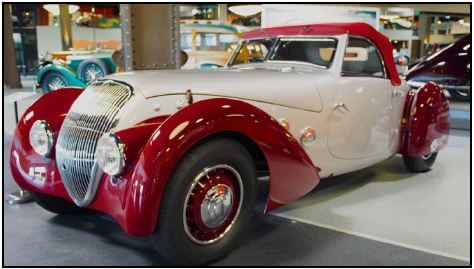
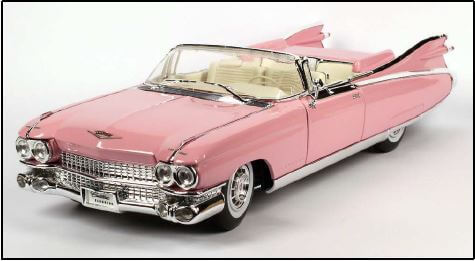
Both cars are inspired by the machine-age. ? The sleek, elongated form of the Bugatti type 57 shows Art Deco's interest in Machine Age, streamlined forms ? and the Cadillac Eldorado's use of fins seems to be inspired by the Modernist's interest in the use of fish forms to depict speed. ?
Art Deco designers aim to create escapist, glamorous, luxury items. ? The Bugatti Type 57 clearly reflects this aim as it is a large, luxury car designed for comfortable travel. ? The Cadillac Eldorado is also a luxury car but the Pop Era's aim to reflect the popular, everyday culture of the time can be seen in the fact that it is exudes a less serious, more fun mood than the Bugatti. ?
The Bugatti is made up of long, sleek curvilinear lines that help to depict both speed and elegance. ? The Cadillac Eldorado's lines are also long and streamlined but they do not end in bulbous curves – instead, they are more angular and sharp exuding energy and fun. ?
The forms of the Bugatti Type 57 car are solid and heavy contributing to its grand and powerful appearance ? whereas the forms of the Eldorado Cadillac are more linear, rectangular and light. ? The bulbous, curving bonnet of the Bugatti could be inspired by the organic forms of Art Nouveau as well as by the teardrop forms resulting from the study of aero-dynamics. ? The Cadillac, on the other hand, consists of flatter, rectangular forms possibly inspired by the Machine Age. ?
The Bugatti's deep red and cream colour-scheme is typical of Art Deco's use of dramatic, theatrical colour and exudes pomp and splendour. ? The pale pink of the Cadillac, on the other hand, is light-hearted. ? It is reminiscent of ice-cream and popular plastic products and reflects the Pop Era's love for the new, artificial range of colours that became possible in paint production. ?
Credit must be given to any other valid statements.
NOTE: A maximum of ONLY 3 marks may be allocated for tabular comparison responses. Use the cognitive levels as guidelines. (10)
Q.4.2 LEVEL | COGNITIVE SKILLS | WEIGHTING | QUESTIONS | MARKS (10) |
Lower Order | Remember, Recall, Recognise, Name | 30% | 4.2 | 1 |
Understand, Explain, Describe, Classify | 4.2 | 2 | ||
Middle Order | Apply, Implement, Organise | 40% | 4.2 | 4 |
Higher Order | Analyse, Compare, Interpret | 30% | 4.2 | 1 |
Evaluate, Reflect, Judge | 4.2 | 1 | ||
Create, Synthesise, Justify | 4.2 | 1 |
TOTAL SECTION B: 30
SECTION C: DESIGN IN A SOCIOCULTURAL/ENVIRONMENTAL AND SUSTAINABLE CONTEXT
QUESTION 5 [20 marks]
Answer EITHER QUESTION 5.1 OR QUESTION 5.2.
5.1 5.1.1 (Allocate 6 marks) 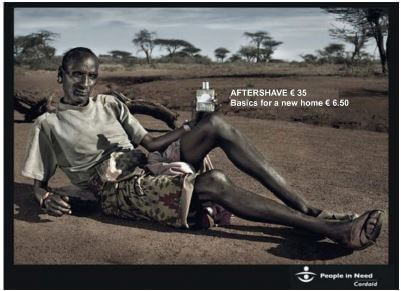
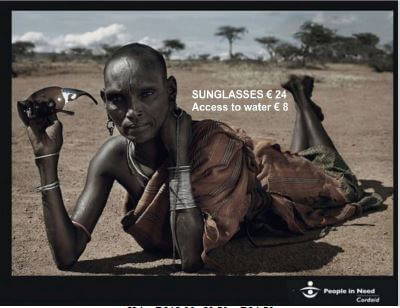
- Use of imagery (Allocate 2 marks)
The social message in the posters above is communicated effectively by the images of emaciated models, portrayed in poses similar to those used by models in high end fashion magazines. ? The Masai models pose with expensive superficial products associated with Western daily life that are not a necessity in their day to day living. ?
The use of font (words written) allows easy understanding of the message. ?
- Colour (Allocate 2 marks)
The Masai models are set against a brown, dreary, barren landscape that depicts drought and may also suggest famine. ? The products that the Masai models are holding on display are catching the eye because of the shiny and sparkling yellow light reflected by the sun on the plastic material of the sunglasses ? and the plastic lid of the aftershave. ? The use of colour in the message (the words) stands out. ?
- Use of juxtaposition (Allocate 2 marks)
The models pose with expensive bling products associated with a fashionable glamorous Westernised existence. However, the Masai models show physical signs of poverty and malnourishment. ? The contrast between the monetary value of the fashion items that the models pose with and that of common basic necessities (clean water, shelter and food) is further emphasised by the written caption. ? This highlights the difference in terms of what money is spent on in first world countries and what that kind of financial facility might mean in third world countries. ?
Credit any other valid statements. (6)
5.1.2 Allocate 14 marks in total, 7 marks per case study. Allocate 1 mark for the name of the designer and the name of the product.
ONE CONTEMPORARY SOUTH AFRICAN DESIGNER/DESIGN GROUP
- Aims that relate to the concept of sociocultural design
Aims of the Lumkani fire alarm is to address/alleviate/improve issues in society that affect the quality of peoples' lives. ? The Lumkani fire alarm is designed for the informal settlements of South Africa, where crowded conditions and open fires used for cooking can result in house fires. ? Fires can easily spread from house to house, devastating and displacing entire communities. ?
- Name and discuss a designer/design group and ONE of his/her/their products that reflects social responsibility
Lumkani Fire Alarm by Socio Tech Institute ?
The Lumkani fire alarm was designed in 2015 by SocioTech Institute. It has a cellular and radio network built in, which alerts neighbours within a 60-metre radius of the location of the fire, through an audio alarm and SMS messages, so the community can respond quickly to extinguish a fire. ? Shelters and shacks in informal settlements are built by hand out of readily available materials that are often highly flammable. ? In addition, these shacks are also often built very close together, hence creating optimal conditions for the rapid spreading of a fire. ? Because of the unplanned nature of informal settlements, these communities are also rarely mapped out making it exceptionally difficult for rescue services to identify the affected places and respond promptly to a fire. ?
ONE INTERNATIONAL DESIGNER/DESIGN GROUP
- Aims that relate to the concept of sociocultural design
Vestergaard LifeStraw is developed to filter out virtually all of the microbiological contaminants that make water unsafe to drink. ? The technology is a personal 'straw-like' filter. It helps people in developing countries who do not have running water piped in from municipal sources and also gives access to safe water in emergency settings following natural disasters when water is contaminated. ?
- Name and discuss a designer/design group and ONE of his/her/their products that reflects social responsibility
Lifestraw by Vestergaard ? The LifeStraw was developed by Vestergaard in 1994. It is a filter that can remove Guinea worm larvae from water it is contaminating. This cloth filter later evolved into a more effective pipe form in 1999. ? Today more than 37 million LifeStraw Guinea Worm filters have contributed to the near-eradication of the disease. ? The LifeStraw team is committed to redefining the safe drinking water space through technology innovation and product quality and design. ? In doing so, our work is driving sustainable access to safe drinking water by engaging governments, donors, and individual consumers to understand the problem and become an active part of the solution. ? Vestergaard recognised that, while the LifeStraw technology was effective for many uses, innovation around product design was important to meet the needs of different groups of people. ? In 2008, LifeStraw technology was adapted for in-home use and the LifeStraw Family water purifier was developed to purify larger volumes of water. ?
The LifeStraw portfolio has continued to evolve to include the high volume LifeStraw Community purifier for institutional settings like schools and clinics (introduced in 2013), ? the LifeStraw Go refillable water bottle (2014) and LifeStraw Mission, a high-volume, collapsible bag ideal for campsites, group hikes and expeditions launched in 2015. ? A portion of the proceeds of consumer sales for any LifeStraw product anywhere in the world goes toward the purchase of LifeStraw Community purifiers which are distributed to schools in developing communities. ? As a result, each consumer purchase provides one school child in a developing community with safe water for an entire school year. ? LifeStraw is ideal for hiking, backpacking, camping, travel and emergency preparedness. ? The straw-style filter design lets you turn up to 1 000 litres of contaminated water into safe drinking water. ? It lets you drink directly from streams and lakes or from any container. ? Uses advanced hollow fibre membrane technology to filter up to 264 gallons or 1 000 litres of water to 0,2 microns. It removes 99,9999% of waterborne bacteria, including E. coli and salmonella and 99,9% waterborne protozoa, including Giardia and Cryptosporidium. ?
Credit any other valid statements. (14) [20]
Q.5.1 LEVEL | COGNITIVE SKILLS | WEIGHTING | QUESTIONS | MARKS (20) |
Lower Order | Remember, Recall, Recognise, Name | 30% | 5.1.1 | 2 |
Understand, Explain, Describe, Classify | 5.1.2 | 4 | ||
Middle Order | Apply, Implement, Organise | 40% | 5.1.1 5.1.2 | 4 4 |
Higher Order | Analyse, Compare, Interpret | 30% | 5.1.2 | 3 |
Evaluate, Reflect, Judge | 5.1.2 | 2 | ||
Create, Synthesise, Justify | 5.1.2 | 1 |
OR
5.2
5.2.1 (Allocate 10 marks, 2 marks per requirement)
XHOSA BEADWORK
- History and social functions Beadwork is used in African society as a means of social differentiation; used to portray the social role, life stage, spiritual state or marital status of the wearer within his/her community. ? Beaded objects also form an important part of traditional African dress and for special occasions such as weddings and festivals. ?
- Materials, methods and processes The materials utilised in traditional Xhosa beadwork are animal sinew and glass beads of which the white beads were favoured. ? Pins used to attach the finished product to the garment are also used. ? Generally the brick or diamond stitching method is used to create precise, geometric patterns and shapes. ?
- A discussion of ONE example and the name(s) of the indigenous cultural community or craftsperson that produced it. The keeper-of-the-heart necklace by the Xhosa cultural community. ? The keeper-of-the-heart necklace is a small beaded panel necklace commonly worn by Xhosa women around their necks communicating how they feel about themselves. ? The necklace has a front square or rectangular panel on which there appears a stylised human figure in coded form. ? The pose of the stylised figure tells us that the wearer considers themselves to be either hardworking, a good dancer and in some instances too old to dance. ? The keeper-of-the-heart necklace is sometimes also worn by men, indicating that the wife is either a good dancer, hard worker or a good housekeeper. ?
- The value of practising this craft in contemporary South Africa Practising traditional craft in contemporary South Africa helps to keep the craft alive and in this way preserves African traditional practices and culture. ? The practice also creates economic prospects for the designer and also gives the designer an opportunity to empower his/her community. ? This is achieved by imparting skills to the community that can potentially improve the economic situation of the community. ?
Credit any other valid statements. (10)
5.2.2 (Allocate 10 marks)
- Name of designer/group and his/her/their design product(s) Xhosa-inspired beadwork iPhone case, Vukile Batyi and Laduma Ngxokolo ?
- A discussion of how traditional techniques/methods and material have been applied to contemporary design. Refer to specific examples to support your statements. The Xhosa beadwork-inspired iPhone case cover is designed using glass beads, drawing on traditional beading techniques to create a 21st century ubiquitous accessory. ? iPhone cases are as popular as the iPhone itself. ? iPhone cases are a fashionable add-on that shields iPhones from screen and moisture damage. ? Inspired by his late aunt, Batyi draws on traditional beading skills to create one-of-a kind, bright and bold designs for the South African and international market. ?
- Discuss whether this/these product(s) make(s) a sociocultural contribution The patterns in which the beads have been laid out are predominantly used in and found in Xhosa culture. ? The use of a traditional technique to adorn and protect a technological gadget creates a contrast of opposites, a new age digital accessory decorated and protected by an old fashioned handmade element. ? The use of Xhosa-inspired patterns for a contemporary design is a way of celebrating previously marginalised societies by acknowledging the contribution to the design world. ? Traditional designers whose work influenced these covers can be paid royalties for the designs thus creating jobs for people from a traditional background. ? Durable traditional Xhosa beadwork technique is used by local skilled South African artisans, thus providing a platform for them to sell their quality items to local and international buyers. ? (10) [20]
Q.5.2 LEVEL | COGNITIVE SKILLS | WEIGHTING | QUESTIONS | MARKS (20) |
Lower Order | Remember, Recall, Recognise, Name | 30% | 5.2.1 5.2.2 | 2 1 |
Understand, Explain, Describe, Classify | 5.2.1 5.2.2 | 2 1 | ||
Middle Order | Apply, Implement, Organise | 40% | 5.2.1 5.2.2 | 4 4 |
Higher Order | Analyse, Compare, Interpret | 30% | 5.2.2 | 2 |
Evaluate, Reflect | 5.2.1 | 2 | ||
Create, Synthesise, Justify | 5.2.2 | 2 |
QUESTION 6 [20 marks]
6.1
6.1.1 (Allocate 4 marks)
The environmental warning in FIGURE K warns people of the dangers caused by plastic pollution of the ocean. ? The poster creates awareness of the impact of plastic pollution on the environment of the sea. This affects the quality of the water supply contained in the ocean, as well as the lifespan of ocean animals and marine plants. ? In humans, plastic pollution can result in severe reactions and illness through physical contact or ingestion of water or food from the ocean. ? The strength of the message is enhanced with the use of a font which is bold, sans serif and uppercase. ? The image of delicious sushi rolls where plastic replaces the seaweed strongly highlights the message of environmental pollution getting out of hand. ?
Credit any other valid statements. (4)
6.1.2 (Allocate 2 marks)
Yes, visually shocking images in a poster campaign can impact on and change people's perceptions of, ? for example the impact of pollution could encourage them to change their habits after seeing shocking images. ?
OR
No, poster campaigns are sometimes not effective in bringing about a change in people's behaviour, because people forget the message of the poster as soon as they walk away from it. ? Out of sight, out of mind is often the people's reaction. ? Legislation should be tightened in various countries to enforce stricter laws regarding issues that impact the environment. ?
Credit any other valid statements. (2)
6.2 (Allocate 14 marks in total, 7 marks per case study)
EXAMPLE OF A SOUTH AFRICAN ENVIRONMENTAL DESIGNER/DESIGN GROUP
Name of the design company: ZETU, name of the shoe: Izimbadada ? The owner of ZETU, a company that manufacturers shoes in rural KwaZulu Natal, and a shoe designer, Reggie Xaba, aims to be fashionable, stylish and edgy whilst embracing their Africaness. ? Izimbadada shoes were made popular by Mbaqanga and Maskandi (South African music genres with rural Zulu roots) musicians who prefer them for their durability when performing Zulu dancing. ? The design of the shoe is inspired by the familiar African surroundings, like the dusty terrains of KwaZulu-Natal, the bustling streets of Johannesburg, Lagos, and Nairobi or of any other African city. ?
These rubber sandals, made entirely from the tread of old tyres were originally worn by people from rural areas who moved to cities to settle in hostels, but has since penetrated the broader spectrum of society as a fashion item. ? The shoes are made heavy and sturdy because Zulu dancing involves a lot of hard stomping that is quite hard on the feet. ? The lighter versions of the traditional handcrafted sandal use modern materials and cutting methods and are decorated with trendy and original patterns. ? While the sandals have a distinguishable sole made from car tyres, designs differ and are often custom-made according to the buyer's request. ? The sandals are comfortable and trendy, with a re-imagined aesthetic of traditional wear. ? This can include cow hide embellished straps to straps that are beaded or embroidered. ?
The creation of these products helps the environment to be cleaner as they are manufactured from waste material. ? These tyres were supposed to be disposed on the landfills but instead they have received a new life as shoes. ? The rubber salvaged from the tyres also reduces the carbon footprint on the environment. ?
Tyres are non-renewable resources ? with the majority of people and the commercial transportation industries discarding their old tyres in landfills. The use of these tyres as materials in the design of products helps minimise waste and the negative impact on the environment. ?
EXAMPLE OF AN INTERNATIONAL DESIGNER
(Allocate 7 marks per case study)
Name of the designer: Laurence Brabant, name of the product: Cold Cuts ? The Cold Cuts collection by Laurence Brabant takes recycled wine bottles and turns them into serving ware and glasses. ? Their aim is to produce unpretentious discreet designs through sophisticated, functional, simple objects. ? The wine bottles are cut and chamfered. Laurence Brabant, uses renewable woods like beech and cork to craft the handles. ?
All Laurence Brabant Editions are handmade in their studio. ? No moulds or modifications are used. Each piece is unique being made in one go that requires seasoned skill and concentration. ? A recycled wine bottle is chosen as a material, for it enables Laurence to produce designs that were otherwise limited by pipe blowing. ? These pieces are heat-resistant and deceivingly durable. Laurence Brabant has managed to create some unique designs that stand out from ordinary recycled bottles. Brabant created unique kitchen utensils like some classy wine glasses and some cute and attractive glasses and more. ?
With Cold Cuts the designer is playing with some standards: these wine bottles which are cut and chamfered have always the same inner diameter as they are turned into vases, candle holders and spoons. ?
The bottle is not bio-degradable, recyclable, up-cyclable or even re-usable bottles that helps to reduce pollution of the environment. ? Recycling reduces manufacturing costs and processes which in return yield bi-products (chemicals) that are imposing danger to the environment. ? With Cold Cuts, Laurence Brabant assists towards cleaning and saving planet earth from hazardous material that damage the environment. ? Glass is a renewable material that can be melted to create new design products. ? The abundant wasted glass means that glass is readily available with our ever growing world population needs. ? (14) [20]
Q.6 LEVEL | COGNITIVE SKILLS | WEIGHTING | QUESTIONS | MARKS (20) |
Lower Order | Remember, Recall, Recognise, Name | 30% | 6.1.1 6.1.2 | 1 1 |
Understand, Explain, Describe, Classify | 6.2 | 4 | ||
Middle Order | Apply, Implement, Organise | 40% | 6.1.2 6.2 | 2 6 |
Higher Order | Analyse, Compare, Interpret | 30% | 6.1.1 | 1 |
Evaluate, Reflect, Judge | 6.1.2 | 1 | ||
Create, Synthesise, Justify | 6.2 | 4 |
TOTAL SECTION C: 40
GRAND TOTAL: 100